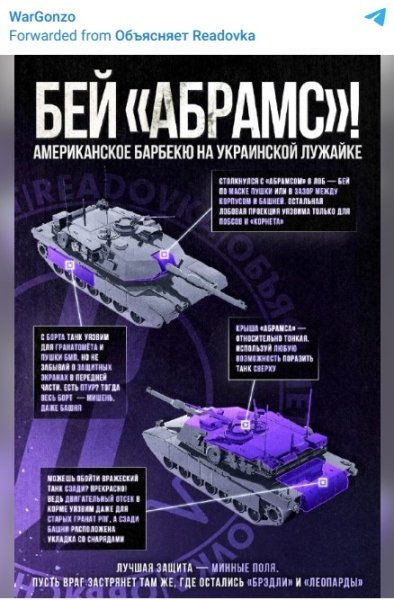
Destroy Abrams: Russian military receives recommendations on how to fight US tanks
A diagram of an American tank with relatively vulnerable spots appeared on Russian social media, on the basis of which two tactics were invented to defeat it. However, Western observers point out that the overall effectiveness of the tank depends on various factors, including crew training, terrain, and operating conditions.
The so-called manual on exploiting potential vulnerabilities of American Abrams tanks appeared in the Russian information field. They contain specific instructions on the choice of targets and weapons, such as the Kornet anti-tank guided missile. This was reported on September 25 by Army Recognition observers.
The authors of the article noted that as soon as it became known that the White House had decided to provide Ukraine with a number of M1 Abrams main battle tanks, Russia said that they would be treated in the same way as other Western weapons on the Ukrainian front.
At the end of January this year, retired Russian colonel Sergei Suvorov expressed his thoughts on this issue. In an interview with the TASS news agency, he spoke about the alleged vulnerabilities of Abrams tanks based on past combat experience, citing examples of the destruction of these APCs in clashes with Soviet T-72 tanks and RPG-7 anti-tank grenade launchers.

He also pointed out the potential vulnerability of later versions of American tanks – an open power plant located in the rear of the hull, which was exposed to fire from a 12.7 mm DShK machine gun.
In general, these recommendations highlight several key tactics. One of them involves the destruction of the guidance systems and main gun of the Abrams tank. The attackers were advised to use small arms or large-caliber machine guns to disable the tank’s guidance system to reduce its accuracy.
In a head-on collision with a tank, it was recommended to hit the gap between the hull and the turret located under the gun. This area is considered less secure than other parts of the tower. During frontal attacks, it is recommended to use the Kornet ATGM. At the same time, it is pointless to strike the lower frontal part of the tank, as it is very well protected.
Another tactic involves targeting the fuel tank located on either side of the driver’s compartment to ignite the fuel and cause a fire in the engine and a possible explosion. At the same time, it was noted that the M1A1 Abrams is equipped with an engine compartment fire extinguishing system.
For attacks from the rear, the author of the manual suggested targeting the engine compartment or an isolated ammunition container in the rear of the turret, as disabling the ammunition was seen as a way to render the tank ineffective.
While these recommendations and tactics have provided insight into the potential vulnerabilities of M1 Abrams tanks, observers write, it must be recognized that the overall effectiveness of the tank depends on a variety of factors, including crew training, terrain, and operating conditions.
“It is also important to note that Russian sources do not always provide a complete picture. For example, unlike Russian tanks, even if an Abrams tank is destroyed, the crew is likely to survive due to the presence of internal protective elements,” the authors emphasized.

